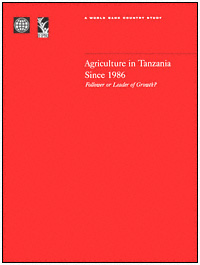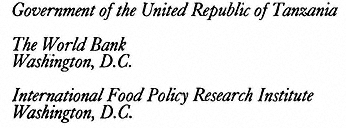Cover

| title | : | Agriculture in Tanzania Since 1986 : Followers or Leader of Growth? World Bank Country Study, 0253-2123 |
| author | : |
| publisher | : | World Bank |
| isbn10 | asin | : | 0821347799 |
| print isbn13 | : | 9780821347799 |
| ebook isbn13 | : | 9780585376554 |
| language | : | English |
| subject | Agriculture--Economic aspects--Tanzania. |
| publication date | : | 2000 |
| lcc | : | HD2128.5.A645 2000eb |
| ddc | : | 338.1/09678/09048 |
| subject | : | Agriculture--Economic aspects--Tanzania. |
Page i
A WORLD BANK COUNTRY STUDY
Agriculture in Tanzania Since 1986
Follower or Leader of Growth?

Page ii
Copyright 2000
The International Bank for Reconstruction
and Development/THE WORLD BANK
1818 H Street, N.W.
Washington, D.C. 20433, U.S.A.
All rights reserved
Manufactured in the United States of America
First printing June 2000
World Bank Country Studies are among the many reports originally prepared for internal use as part of the continuing analysis by the Bank of the economic and related conditions of its developing member countries and of its dialogues with the governments. Some of the reports are published in this series with the least possible delay for the use of governments and the academic, business and financial, and development communities. The typescript of this paper therefore has not been prepared in accordance with the procedures appropriate to formal printed texts, and the World Bank accepts no responsibility for errors. Some sources cited in this paper may be informal documents that are not readily available.
The findings, interpretations, and conclusions expressed in this paper are entirely those of the author(s) and should not be attributed in any manner to the World Bank, to its affiliated organizations, or to members of its Board of Executive Directors or the countries they represent. The World Bank does not guarantee the accuracy of the data included in this publication and accepts no responsibility for any consequence of their use. The boundaries, colors, denominations, and other information shown on any map in this volume do not imply on the part of the World Bank Group any judgment on the legal status of any territory or the endorsement or acceptance of such boundaries.
The material in this publication is copyrighted. The World Bank encourages dissemination of its work and will normally grant permission promptly.
Permission to photocopy items for internal or personal use, for the internal or personal use of specific clients, or for educational classroom use, is granted by the World Bank provided that the appropriate fee is paid directly to Copyright Clearance Center, Inc., 222 Rosewood Drive, Danvers, MA 01923, U.S.A., telephone 978-750-8400, fax 978-750-4470. Please contact Copyright Clearance Center prior to photocopying items.
For permission to reprint individual articles or chapters, please fax your request with complete information to the Republication Department, Copyright Clearance Center, fax 978-750-4470.
All other queries on rights and licenses should be addressed to the World Bank at the address above, or fax no. 202-522-2422.
ISBN: 0-8213-4779-9
ISSN: 0253-2123
Library of Congress Cataloging-in-Publication Data has been applied for.
Page iii
Contents *
| Abstract | ix |
| Preface | xi |
| Acknowledgment | xii |
| Executive Summary | xiii |
| 1. Agricultural Controversies in Tanzanias Development Strategy Debate | 1 |
| 1.1 Four Key Issues Concerning the Place of Agriculture in Tanzanias Economy | 2 |
| 1.2 Approach of the Report | 3 |
| 1.3 Outline of the Report | 3 |
| 2. Evolution of Public Policy Affecting Agriculture | 5 |
| 2.1 Between Independence and the Arusha Declaration (19611966) | 5 |
| 2.2 From the Arusha Declaration to the Reform Era (19671985) | 5 |
| 2.3 During the Early Reform Period (19861992) | 6 |
| 2.4 The Period Since 1993 | 8 |
| 2.5 Government Expenditure on Agriculture | 9 |
| 3. Evolving Output Price Incentives for Agricultural Production Since 1986 | 17 |
| 3.1 Evolution of Food Prices | 17 |
| 3.2 Differences Between Tradable and Non-tradable Agricultural Goods | 18 |
| 3.3 Food Price Behavior and Evidence of Non-tradability of Some Major Staples | 19 |
| 3.4 Implications of Non-tradability of Food Staples for Incentives | 21 |
| 3.5 Evolution of Output Prices for Traditional Export Crops | 22 |
| 3.6 Explicit Agricultural Taxation | 24 |
| 3.7 Relative Profitability for Smallholders of Cash and Food Crops | 25 |
| 4. Costs and Returns to Crop Production | 36 |
| 4.1 Inter-regional Food Crop Marketing Costs | 36 |
| 4.2 Export Crop Marketing Costs | 38 |
| 4.3 Use of Agricultural Inputs | 38 |
| 4.4 Input and Small-scale Agricultural Investment Credit | 40 |
| 4.5 Unfavorable Trends in the Ratio of Crop to Input Prices | 42 |
* This technical report was prepared by the International Food Policy Research Institute Washington D.C., in November 1999, for the joint United Republic of TanzaniaWorld Bank Country Economic Memorandum., Tanzania at the Turn of the Century: From Reforms to Sustained Growth and Poverty Reduction, 2000. The authors, Dr. C. L. Delgado and Dr. N. W. Minot, based the report on background papers contributed by various Ministries in the Government of Tanzania, University of Dar es Salaam, Institute for Development Management (Morogoro) and IFPRI.
Page iv
| 4.6 Impact of Rising Input Prices on the Profitability of Crop Agriculture | 43 |
| 4.7 The Difficult Institutional Transition Under Liberalization | 44 |
| 5. Performance of Agriculture | 49 |
| 5.1 Assessment of Agricultural Production Data | 50 |
| 5.2 Food Production Performance | 53 |
| 5.3 Performance of Export Crops | 57 |
| 5.4 Performance of Agricultural GDP on the Crop Side | 60 |
| 5.5 Performance of the Livestock Sector | 61 |
| 5.6 Performance of the Fisheries Sector | 62 |
| 5.7 Summary | 63 |
| 6. Rural Poverty and Food Security | 96 |
| 6.1 Rural Poverty in Tanzania | 96 |
| 6.2 Food Security |
Next page


